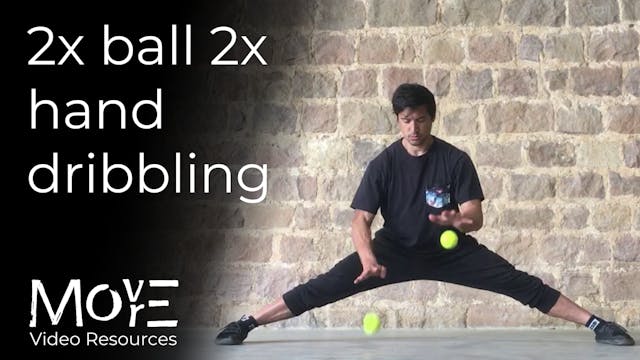Close-range Ball-dribbling
Timing, rhythm, and coordination
•
51s
THE WHAT:
A fundamental context for exploring timing, rhythm, & hand-eye coordination as well as power-management (how hard to hit the ball), object manipulation and focus. Do not, however, expect that practicing this task alone will develop those aforementioned qualities in any significant or well-rounded manner. Unlike physical capacities such as "strength" & "mobility", these are very CONTEXT-specific qualities and, in order to develop them, therefore, LATERAL experience across a wide-range of movement contexts is key. This frame is therefore just a drop in an ocean - "but what is an ocean if not a multitude of drops?" (David Mitchell, Cloud Atlas)
Whilst sets for time (i.e. how long you bounce the ball 'unbroken') provide the most practical structure for practice, I advise that you do not focus too attention on trying to lengthen your 'unbroken' time-streak. It can lead to an over-focus on goals/benchmarks, rather than what I believe truly matters: simply accumulating general experience with the task itself (regardless of 'success' or 'failure'). As this task is very conducive to a re-setup (i.e. you rarely have to go running after the ball), frustration is actually quite low in comparison to other ball tasks (such as standing dribbling or juggling). It makes the context very easy easy to 'lose yourself' in for a predetermined period of time which, in my opinion, contributes hugely to its child-like charm.
I therefore advise simply ACCUMULATING time in the position (squat) for anywhere between 5-20 minutes per session. Start your timer when you start the task, stop it when you get bored/you can squat no longer, and give no weight to how long you bounce the ball unbroken. This perspective in itself (reducing investment in goals / 'deambitioning') is ultimately a highly transferable and valuable frustration-management tool.
Spending this time in the squat of course also contributes to one face of mobility development and also toward the cultivation of 'floor-culture' (i.e. re-/building a habit of being on and in close-contact with the floor). As a strongly focus-dependent task, it can also be used effectively to engage practitioners and/or to "prime" the eyes & nervous system for further ball-related movement contexts and can be used as such in classes and your own practice. Resource contexts:
0:05 - Single-hand dribble - work BOTH hands
MILESTONE: 30" unbroken dribbling ea. hand
0:21 - Double-hand dribble
MILESTONE: 60" unbroken dribbling
___________________
For programming, guidance, & support for your physical practice:
The 'Video Resource Library' (VRL): https://www.movemorevrl.com/browse
FREE fundamental prehabilitation program: https://www.movemoremp.com
Online Support (1 to 1 coaching): https://movemoremp.com/onlinesupport
Elements (standardised programs): https://www.movemoremp.com/elements
[email protected]
Up Next in Timing, rhythm, and coordination
-
2x ball 2x hand dribbling
THE WHAT:
A context for developing timing, rhythm, & coordination with hands as well as judgement & power-management (bouncing ball).MILESTONES:
- 30" / 1min / 2mins unbroken bouncing in squat
- 30" / 1min / 2mins unbroken bouncing with 'level changing'
- 30" / 1min / 2mins unbroken bouncing mo... -
Tennis ball foot dribbling 1
THE WHAT & HOW:
Using a tennis ball to develop "soft" qualities such as rhythm, timing, & coordination of the feet. Although foot-eye coordination oriented, full-body coordination is also developed as structure & positioning are key to successful & rhythmical striking of the ball. Be mindful of t... -
Tennis ball foot dribbling 2
THE WHAT:
Using a tennis ball to develop rhythm, timing, & coordination of the feet. Although foot-oriented, full-body coordination is also affected as structure & positioning are key to successful & rhythmical striking of the ball. Be mindful of the tendency to 'block' the upper-body (holding te...



